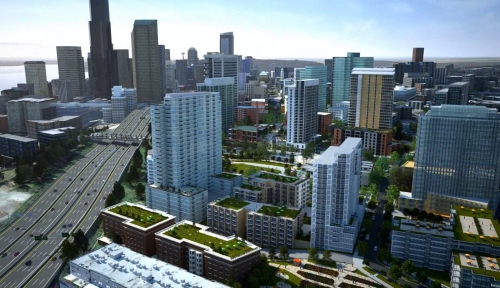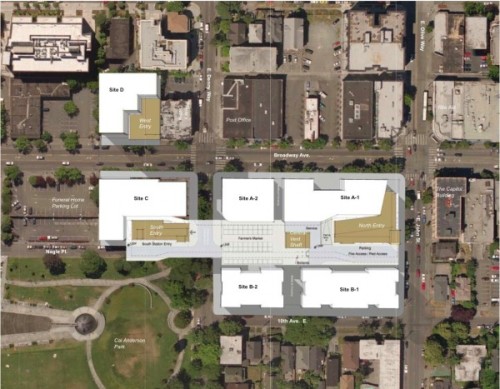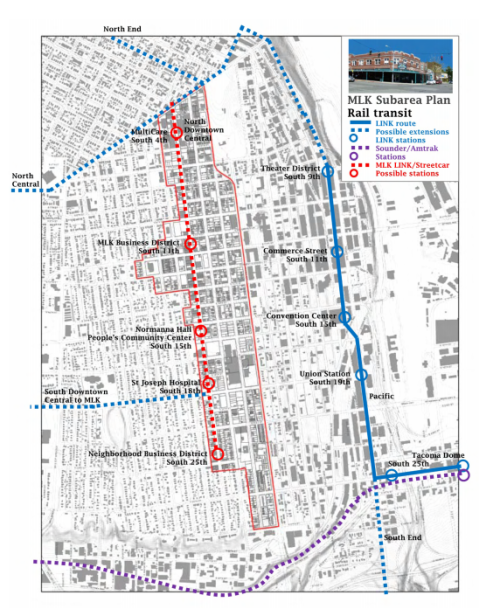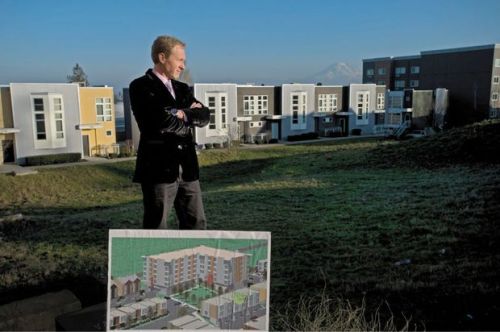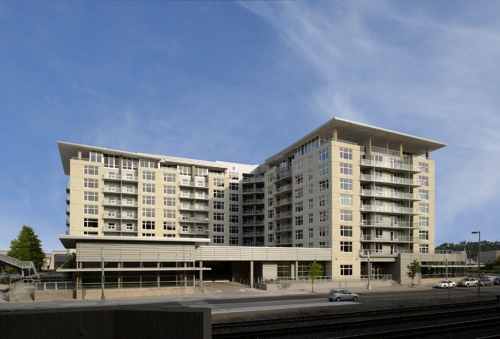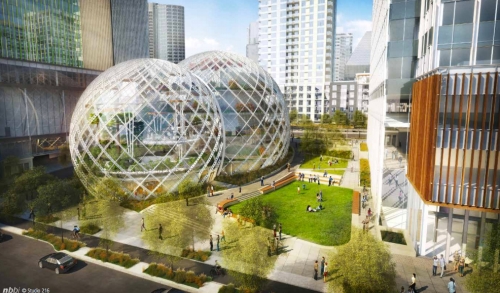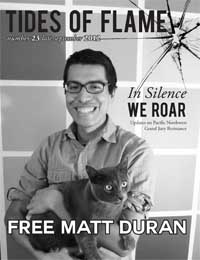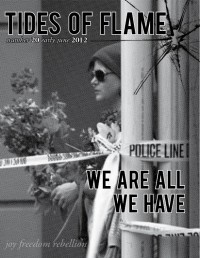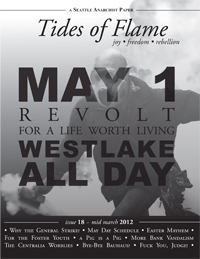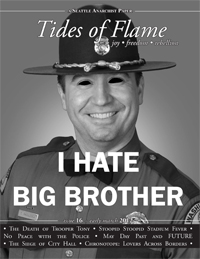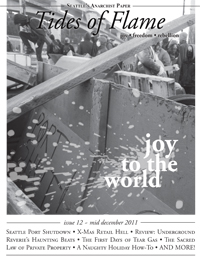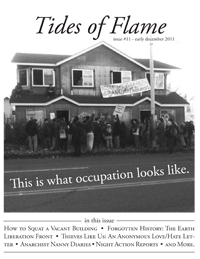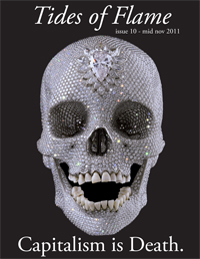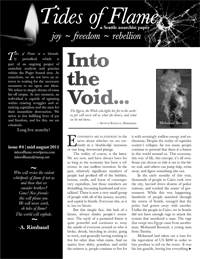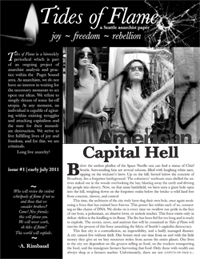Yesterday, I spent 20 minutes watching a crew tear down a brick wall, and I thought of the workers, long since dead, who first built that wall. As much as I love the new, I remain haunted by the old. Just like you. Just like this neighborhood.
-Sherman Alexie, South Lake Union, 2012
Energy
This story starts, simply enough, with some power lines. Puget Sound Energy (PSE) has begun advertising its new plan: Energize Eastside. They propose to build 18 miles of additional electrical transmission lines between Renton and Redmond. The new lines will be able to handle 230 kilovolts as opposed to the current 115 kilovolt lines. In the process of building this new infrastructure, PSE will seize land from private owners, tear down more trees, and in certain cases bulldoze entire houses.
PSE is promoting Energize Eastside as a necessary expansion that will decrease the chance of blackouts during future storms. However, it is no secret that the Microsoft campus is in Redmond where the proposed power lines begin and that a Boeing factory is in Renton where the proposed power lines end. Scattered around these new lines are the Costco headquarters in Issaquah, T-Mobile US headquarters in Bellevue, and Google’s expanding Kirkland campus. Energize Eastside is built for these companies and the project reflects their needs.
For example, Microsoft has a nearly secret data center in Tukwila that barely shows up in any search algorithm. Located at 3333 S. 120th Place, just down the hill from the Seattle Department of Homeland Security headquarters, the T5 data center houses an unknown amount of Microsoft servers. This data center uses a massive amount of electricity and represents only a fraction of Microsoft’s local energy needs.
On March 19th, PSE will host their first neighborhood meetings on the proposed route of the Energize Eastside power lines. Redmond, Bellevue, and Renton will each host several of these meetings until May. It will most prudent to attend these events and make them difficult for the architects of this new corporate project.
The SLUT
We have already seen the effects of a different corporate project on the streets of Seattle. Paul Allen, co-founder of Microsoft, had the city build an electric streetcar from Downtown to his Vulcan Inc. properties in South Lake Union. It started running in 2007 and on the street this streetcar is known as “the SLUT.” Ever the thoughtful capitalist, Allen hoped to lure potential tenants with this city-funded corporate infrastructure. In December of 2007, the same month the SLUT went online, Amazon announced it was moving from Beacon Hill to the Vulcan properties in South Lake Union. Paul Allen’s streetcar certainly succeeded in closing the deal with Amazon and lured them into their present location. Allen later sold the property to Amazon for one billions dollars, cashing out like a bandit.
In the meantime, the same electric streetcar network is now spreading through Downtown and up the hills. Track construction for the First Hill Streetcar has tore up Jackson Street in the International District for many months, making it look like a war zone or disaster area. The tracks leave Little Saigon and travel up towards Yesler Terrace and the new development there. Despite opposition to the project, the existing low-income housing in Yesler Housing is now being destroyed to make way for new high-end apartments.
The Seattle Housing Authority and Vulcan have teamed up to reshape Yessler Terrace and make it more profitable and sterilized. In total there will be 850 low-income units surrounded by at least 1,500 market-rate housing units. Conveniently for Vulcan, the First Hill Streetcar passes through the future site of their new luxury apartments. Currently, the old buildings that made up the Yesler Terrace community are now being destroyed one at a time, making way for 1,500 new rich people who will live in the towers overlooking Eliot Bay.
In his 2014 state of the city address, mayor Ed Murray announced he would be pushing to connect all the streetcar lines. If an additional streetcar line is built between the First Hill Streetcar and the SLUT, a new network will have been created that links them all together with two Sound Transit light rail stations. The first of these is the International District station, located where the First Hill Streetcar and the proposed First Avenue Streetcar meet. The second is the Capitol Hill light rail station, located where the First Hill line terminates.
When completed, this station will allow passengers to travel from the University District to Capitol Hill more quickly than if they rode the bus. After construction is done, there will be several new parcels of land that will be sold off to the highest bidder. Bids are now being submitted to Sound Transit and the picks will be announced in October of 2014. The city just allowed any of these potential developers to build 85-feet buildings as long as they build the minimum low-income housing. If everything goes as planned, the area around the corner of Broadway and Denny will be unrecognizable and a new, powerful node of hyper-gentrification will be in place.
We all can see a vastly altered Capitol Hill, with new buildings rising every month. The streetcar projects are moving synchronically with this new development. Once they come online, these streetcars will keep money flowing in and throughout these hyper-gentrified areas. Just as Paul Allen lured Amazon with the SLUT, these streetcars will lure potential residents and investors. As we all know, the poor will be pushed even further away from the center to the north and the south. While rich techies may call them uncreative or lazy, these displaced people are always the most exploited in the metropolis. They work to keep it all running.
Train to Tacoma
Speaking of the south, it was recently announced that the light rail line Sound Transit operates in Tacoma will begin charging fares in September, 2014. Since it was completed in 2003, the Tacoma Link has delivered weekenders, tourists, and the street population from Downtown to the Tacoma Dome for absolutely free. Now, over a decade later, Sound Transit announced it would begin charging a one dollar fare. This coincides with their plans to expand the line up the hill into the Stadium District and then west into the Hilltop neighborhood down Martin Luther King Jr. Way.
Whereas the Stadium District has always been affluent and white, Hilltop has largely been black and impoverished. In a story repeated in many other cities, the once thriving black diaspora that settled down after WWII was undermined by discriminatory economic policies, institutionalized racism, police terror, and imported narcotics. None of these factors that lead to the Mother’s Day riots of 1969 were ever addressed and black youth faced a grim life on the streets of Tacoma.
When a group of Crips suddenly arrived in 1984, bringing with them cocaine imported by the CIA, there was suddenly the chance for quick economic prosperity amidst a US economy in recession. The turf wars that began in 1984 over drug territory did not stop for nearly two decades.
After the violence was sufficiently lowered and the Hilltop black community shattered by internal warfare, a city-sponsored development scheme was hatched between the developers, the police, the county prosecutor, and the creative class, a fictional group of people thought up by a man named Richard Florida. According to him, the creative class was composed of techies, small business owners, and artists. If they were imported, revitalization would occur.
Florida hypnotized most of the Tacoma city council with his fairy tales and while new developments rose around the city, accompanied by an artificially imposed artists community that was hyped up to boisterous levels. Much of this development occurred at the edge of the Hilltop, near the fields that had once been houses condemned and torn down by the police and city.
This development took place in a neighborhood traumatized by years of violence and terror, years that are barely documented. During this initial gentrification effort, the city tried to rename the neighborhood Upper Tacoma, hoping to erase the brutal history of what had happened in the Hilltop. This effort ultimately failed and the neighborhood retained the same name.
On the Thea Foss Waterway below the Hilltop, luxury condo buildings rose into the air amidst this frenzy. Just as they were nearing completion, it became quite clear that capitalism was going into a downfall. When asked about the condo market in Tacoma, the sales manager for The Esplanade replied, “What market?” The Esplanade building was foreclosed on in 2009 and it seemed as if Tacoma would become a perfect example of failed gentrification: soulless, imposed, and doomed to fail. For the past six years this has been the case.
Which brings us back to trains. It seems as if the Tacoma gentry want to have another go at it and are gearing up for spillover from Seattle. The proposed extension of the Tacoma Link to the Hilltop is a signal that gentrification is starting again. With the condos finally filling up on the waterway and the city offering 8-12 year tax exemptions for developers, all the doors are open for a second wave far more terrible than the previous one.
The new one dollar fare for the Tacoma Link is meant to drive the poor away and prime downtown for an influx of new, wealthy residents. Originally built to prove itself to Seattle, Sound Transit was content to let Tacoma have its free transit in exchange for securing the highly profitable revenue from the Seattle system. Now that Sound Transit thinks it can make a buck off the city, there are no more free rides for the streets of Tacoma.
The Feeding of the 12,000
The Free Ride Area of Seattle is now a nearly forgotten memory. When it existed, the Free Ride Area allowed the street population to traverse Downtown quickly and easily, making their lives a bit easier. As more money flowed into Seattle and the streets grew richer, it was only a matter of time until the free rides vanished. Tourists and techies were not supposed to see the poverty of the city when they rode the bus. They were supposed to see the green city, the tech city, the clean city. In September of 2012, the Metro ended the Free Ride Area, ending a loophole that enabled tens of thousands of people to have free transit.
There are still hotspots of crime and poverty in the city center. The transit corridor near 3rd and Pine is always lively and filled with chaos, reflecting the true composition of the metropolitan area. Acute poverty and homelessness stands in stark contrast with extreme wealth and affluence on the Downtown streets. It is plainly visible and despite their efforts, the Seattle capitalists have been unable to get rid of it.
Back down at the end of the SLUT line, South Lake Union looks real clean, quite the opposite of Downtown. As Sherman Alexie famously asked in 2012: “Where is the live music? Where are the street performers? Where are the old men sitting in lawn chairs? Where is the dancing?” Alexie never hid his contempt for Amazon in his column in The Stranger. Not only was the company altering his neighborhood, they were looking to shake him and other authors down for a bigger piece of their sales.
Whenever the New York publishing companies would rebel against Amazon’s grip on the market, the company simply removed those publisher’s titles from their search algorithms. This relationship between Amazon and publishers also exists between Amazon and the City of Seattle. As Alexie explained, “I often and sadistically hope that Amazon will collapse beneath the weight of its corporate ego and libertarian bullshit. But I also know that the local economy would be devastated if Amazon were critically injured. Call it a morally fraught capitalistic dilemma. Or a capitalistically corrupted moral dilemma.”
There certainly is a dilemma, but the hyper-gentrification of Seattle will not wait for Alexie or other liberals to figure out which side they are on. Amazon is currently preparing to massively expand their campus and bring in 12,000 new employees. In the works are three massive office towers surrounding a multistory bio-dome. Inside the dome, the 12,000 new employees will enjoy their lunches inside a rich garden atmosphere. Outside, everyone will be forced to see the upper classes hanging above them in luxury, sealed off in their own private paradise, immune from the poverty outside.
These 12,000 will move into all the new condos and apartments planned to be built in Capitol Hill, Ballard, West Seattle, and the Central District. They will spend their high wages in these neighborhoods but their appetites will be too refined for what the residents eat and love. Even more swanky establishments will push out the old ones and more people will be put to work as dishwashers, dog walkers, nannies, baristas, janitors, security guards, and waitresses. Some will embrace their jobs and feel part of a team. But the majority of these workers will have a class hatred not seen in the US since the turn of the twentieth century. If all of these development and expansion plans are actualized, the conditions will be so stark and the lines so clear in Seattle that capitalism will once again be the enemy for the majority of the population.
No one has to feed the 12,000 when they arrive. Although they may have their bio-dome and luxury condos and electric trains, these people will have to live beside us. Let us hope that by the time they arrive, the resistance is well incubated.
Zap!
Which brings us right back to power lines. Everything described here in this article is only possible because of electricity. In fact, capitalism is becoming more and more addicted to higher amounts of it. Everyone needs to charge their cellphones, plug in their computers, and light their offices in order to work their high-paying jobs.
The electrical grid is taxed and old, just as it is everywhere, but Microsoft, Google, and Amazon just want more and more from it. It does not matter where the electricity comes from, so long as their centers do not crash and everyone can still transmit their data. Energize Eastside is a frantic effort to keep these corporations centered in Seattle. If these corporations leave or vanish, the city will be in a revolutionary situation.
There are many directions to take, but it would be most prudent to begin forming actual plans for the exit from capitalism. While we struggle against these titanic forces, never forget the world that exists within your hearts and always fight to bring it into being. It is the only world that matters in this madness.


